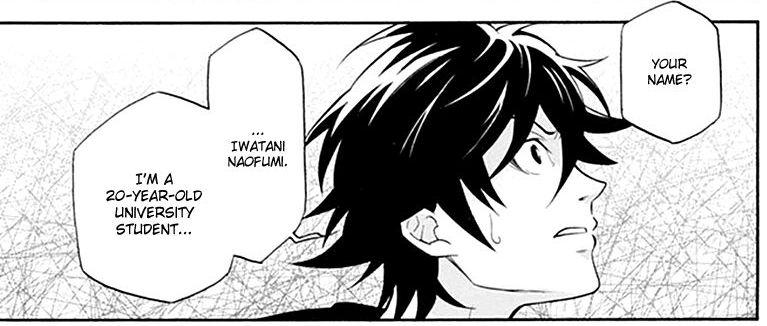The Shield Hero Manga Rises
The critique, “The book was better” is cliche because it’s typically true. While novels lack visual motion and color, and lack a soundtrack, prose is able to vividly describe a greater range of ideas than visuals alone can. And prose isn’t limited by running time or budget, so novels can depict an infinite amount of detail. But graphic artist Aiya Kyu’s manga adaptation of Aneko Yusagi’s Rising of the Shield Hero novel is an exception to the rule. The first Rising of the Shield Hero manga is an unusual example of an adaptation that actually is superior to the original book.
Aneko Yusagi’s Shield Hero web novel series has proven inexplicably popular with readers around the globe. The novel series launches from the commonplace trope of the young protagonist transported from a mundane life to the role of a savior hero in an alternate fantasy-esque world. Where the Shield Hero series introduces its unique angle is in immediately turning the “hero” into an ostracized pariah, a young man who spitefully accepts his destined role as savior on behalf of a populace that doesn’t want him as its champion. Many readers seem to excuse the “hero” Naofumi Iwatani’s cynical and even borderline unethical behavior by justifying it as a necessary and obligatory response to the harsh treatment he receives. So unlike many comparable hero-in-a-fantasy-world scenarios, Shield Hero turns its protagonist into a sort of anti-hero.
Yusagi’s original novels include a shocking dearth of detailed description. Moreover, the original novels exhibit an appallingly limited grasp of fundamental narrative writing skill. The books are filled with careless contradictions, such as the author specifying that a certain magic spell cannot be used in rapid succession, yet mere pages later the author depicting a character using the very same spell multiple times in rapid succession, or the author stating that there isn’t a town on the other side of the forest, then the protagonist visiting the town on the other side of the forest. The original novels also frequently lack attribution for speech, meaning that readers can’t distinguish who is speaking during conversations. In effect, the original novels read like screenplays lacking vital stage directions.
Since the original novels are written like scripts for an adaptation, it’s no surprise that the manga adaptation actually works better on page than the original novels do. The 168-page first Shield Hero manga covers roughly the first half of the first prose novel. Pacing during the manga’s first chapter feels just a bit rushed, but once the manga story introduces supporting character Raphtalia, the manga becomes more considered and evocative. Although the manga adaptation does exclude some content present in the original novel, the exclusion largely works in favor of the manga. Early pointless discussion between the summoned heroes gets condensed. Interminable pages of redundant “monster farming” to level up gets thankfully condensed in the manga adaptation. In the novel, a short scene of Naofumi defending Raphtalia from bullies contributes to establishing Naofumi’s parental protectiveness over his charge. While the brief scene is missing in the manga, the absence isn’t noticeable because the manga includes multiple other scenarios that establish the same characterization. To its credit, the manga also excludes Naofumi’s constant inner monologues. Hearing Naofumi’s thoughts in the original novel provides a much rounder characterization of the protagonist, but hearing Naofumi’s frequently sexist, cruel, selfish, ignorant, and immoral personal thoughts in the original novels actually makes him a far less endearing character. In effect, by excluding an omniscient perspective, the manga’s depiction of Naofumi is still nuanced, and troubling, but more sympathetic.
Aiya Kyu’s graphic art, based on the original novel illustrations by Minami Seira, is crisp and clean with a strong feel for cinematic perspective. Panel layout is dynamic yet easy to follow, and the art does a good job of emphasizing motion, giving the two-dimensional art visual depth and activity. Kyu’s art also makes excellent use of evocative close-ups and stylized emotional reactions that focus attention on personality and characterization. The visual art really emphasizes the mood swings and the changes in emotion that characters encounter, making the manga emotionally affecting. The graphic art includes no nudity or sex. Violence is often bloody, but the visual art deftly keeps the depiction of the graphic gore tastefully restrained. The book’s first four pages, originally serialized in color, are reproduced in monochrome in the domestic collected edition. Japanese visual sound effects are retained but usually unobtrusively translated. The translation itself is concise and effective.
The first manga volume contains four chapters plus a short bonus chapter that fills in some of the content excluded from the first chapter. The manga collection also includes an exclusive two-page prequel story by author Aneko Yusagi set immediately prior to the beginning of the first prose novel, so even readers that have read the novel may still be interested in this manga adaptation, not only for the visual aspect, but also for the exclusive prose bonus.
Aneko Yusagi’s Shield Hero franchise appears to be “critic proof,” as readers continue to eagerly consume the story in spite of justifiably harsh critical reviews. Readers that are curious about the narrative, along with devout fans of the franchise, would be well served to pick up Aiya Kyu’s “manga companion,” in supplement to or even in lieu of the original first novel. Although the first manga volume doesn’t cover the entirety of the first novel, the content that it does cover is presented in a more concise and affecting manner than the redundant and weakly composed original novel.






